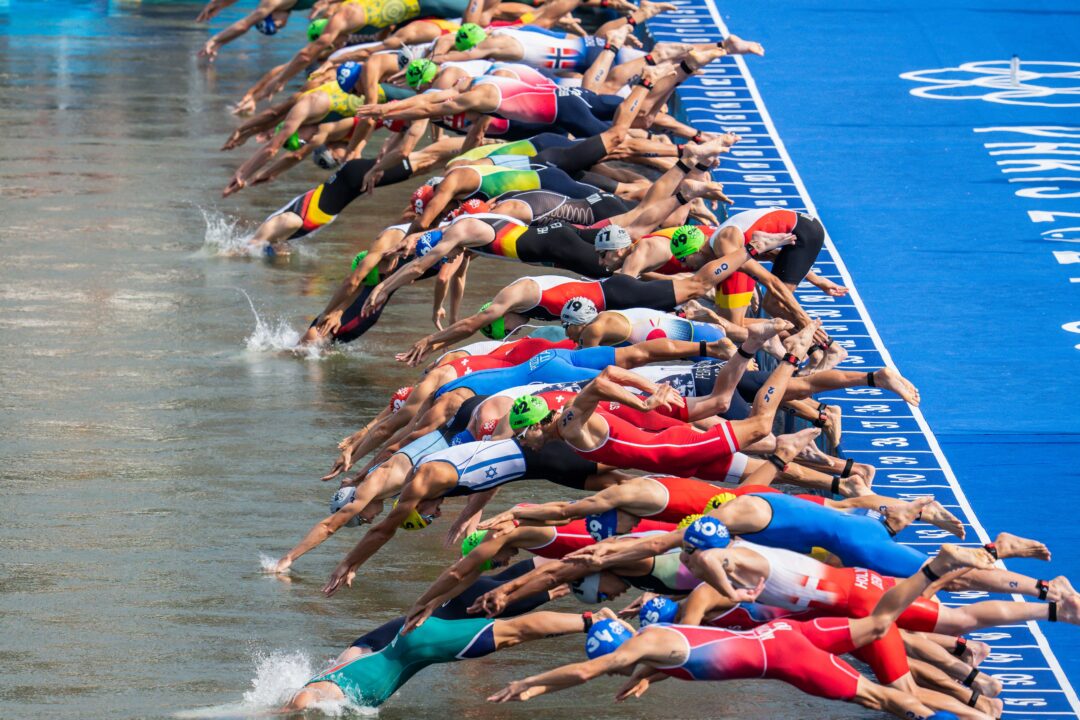Though the Olympic triathlon events successfully kicked off in the Seine River in Paris earlier this week, there remains a lingering concern about the presence of the harmful bacteria E. coli in the water.
According to a report published by ESPN following the conclusion of the triathlon events, the Paris 2024 Organizing Committee gave the green light for the races to occur on Wednesday based on bacteria monitoring results. However, some of those results reportedly fell outside of World Triathlon’s threshold for safe swimming, with one of the four testing sites along the Seine reporting numbers in a range of 980 to 1,553 colony forming units (CFU)/100 mL of water.
For reference, the World Triathlon Association sets their water quality standards for inland waterways at the following:
- Enterococci score: <200 is Excellent; <400 is Good; <330 is Sufficient
- Coli score: <500 is Excellent; <900 is Good; <1000 is Sufficient
In a statement regarding the results of their testing, Aurelie Merle, the Paris 2024 Director of Sports, said that the testing results taken prior to the competition were “very close to the threshold of triathlon”. Merle also indicated that the thresholds were intended to act as a guide, rather than a definitive point of reference.
In addition to the results published by the Paris Organizing Committee, Fluidion, an independent company, has published their own data from tests on the Seine River. Using their Fluidion® ALERT LAB system, the company was able to obtain real-time bacterial counts in the Seine. As of 11:30 PM on July 30th, they reported a planktonic (free floating) E. coli count of 868 cfu /100 mL and a comprehensive E. coli count of 2870 cfu/100 mL. Though the platonic E. coli count fell just below World Triathlon’s standards, the comprehensive count came in well above the standard.
Fluidion also releases laboratory testing numbers for their E. coli counts. According to their website, the company utilizes the IDEXX Colilert-18 Quantitray-2000 in order to generate a “most probable number” (MPN) for their E. coli counts. With the incubation period on the IDEXX system set at a minimum of 18 hours, the results of the July 30th testing are not available yet. However, based on past trends, Fluidion expects the MPN number to fall slightly over the platonic E. coli count.
What Does This Mean?
Though Fluidon’s MPN numbers are not available at the moment, we can utilize their known platonic E. coli count to examine the situation. Uder the IDEXX system, scientists assume a 95% confidence interval for all results. Thus, by using the 868 cfu/100 mL count, we can estimate the rough interval that will be expected with the IDEXX MPN. For these purposes, we will round up to the closest available MPN number on the IDEXX chart, which is 870.4 cfu/100mL of water. With that assumed MPN number, the lower limit of the bacteria count would fall at 654.5 cfu/100mL, while the upper limit would fall at 1153.8 cfu/100mL. At the lower limit of this estimate, the E. coli count would fall well below World Triathlon’s standards for safe swimming (<900 is Good). However, at its potential highest point, the standard would fall well above World Triathlon’s marks (<1000 is Sufficient). Thus, we are able to conclude based on this data that there was a health risk presented to the triathletes who competed in the Seine, though the degree of that risk remains uncertain.
Using the same methodology, we can examine the numbers presented by the Paris 2024 organizers as well. For this purpose, we will examine the number using the lower end of the range provided by the organizers, 980 cfu/100mL. According to the table presented by IDEXX, the next-closest value stands at 980.4 cfu/100 mL. Thus, we can establish a lower range of 660.6 cfu/100mL and an upper range of 1410.2 cfu/100mL. Like the previous situation, the lower range of this interval falls well within World Triathlon standards, but the upper range falls well outside of them, presenting another degree of uncertainty.
What About Open Water Swimming?
World Aquatics has its own standards for safe swimming that differ from those of World Triathlon. Those standards are as follows:
- Enterococci score: <200 is Excellent; <400 is Good; >400 is Unacceptable
- Coli score: <500 is Excellent; <1,000 is Good; >1,000 is Unacceptable
Using both situations explained above, the numbers fall within the World Aquatics standards at their lower range and outside of them at their upper range.
With the base E. coli counts already falling extremely close to the 1000 cfu/100mL mark set by World Aquatics, it’s extremely likely that another round of rain could push these numbers over the edge. Generally, as long as the base number falls within the range, it is considered “safe”, even if the upper limit exceeds that number. However, in the instance that both the upper and lower limits exceed the safe swimming standards, then the health risk is significantly increased.
Data provided courtesy of the Fluidion Open Data Initiative
